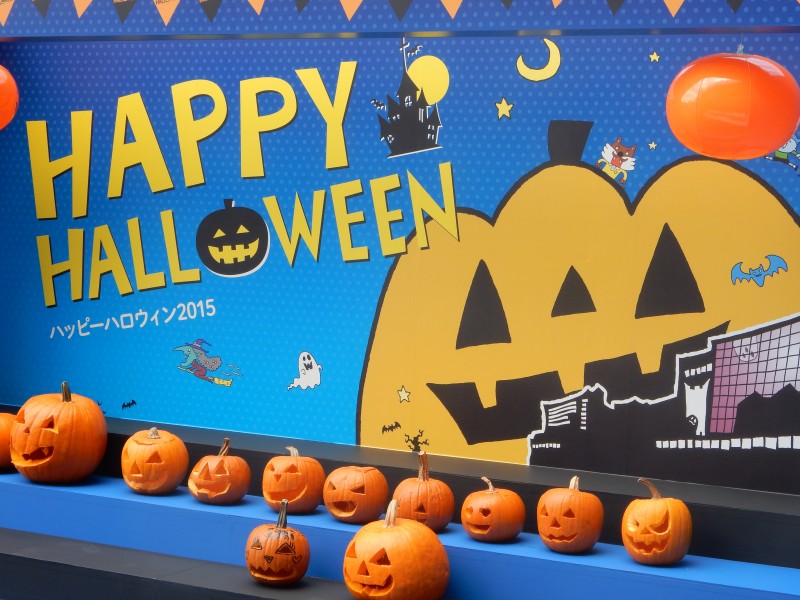
Large poster greeting visitors to Kyoto at the JR Station. All part of the Japanese tradition of celebrating seasonal events.
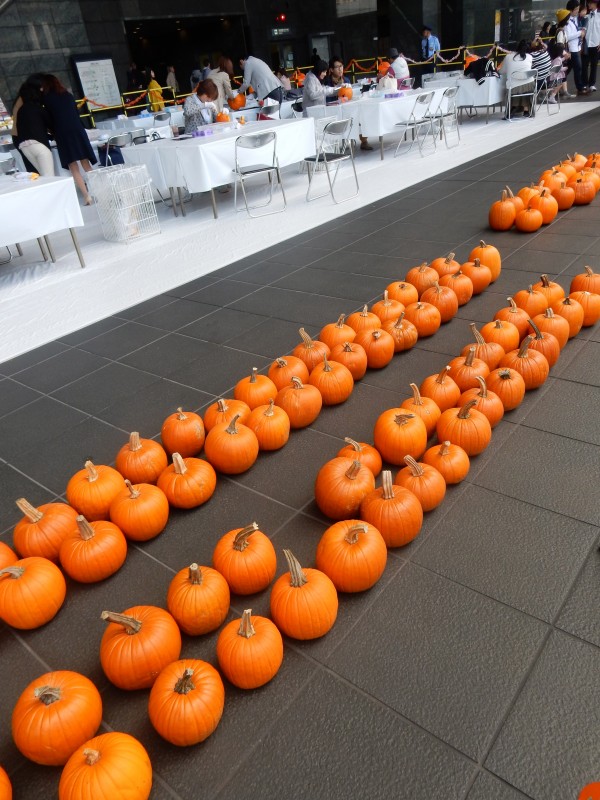
Display of pumpkins for lantern-making at Kyoto Station
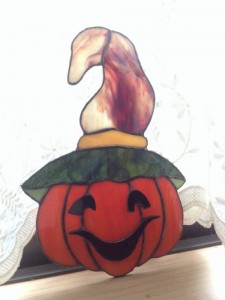 There’s been a notable upturn in Halloween decorations this year in Japan, and I have the impression the festival is about to be celebrated with more gusto here than in the West. Green Shinto has written before of the way the holiday is being absorbed into the Japanese calendar, and right before our eyes we’re witnessing the cultural tendency to adopt and adapt foreign practices (while keeping foreign migrants out). It won’t be too long before the adapted Halloween is considered a ‘traditional holiday’, just as all the Chinese practices now thought of as typically Japanese.
There’s been a notable upturn in Halloween decorations this year in Japan, and I have the impression the festival is about to be celebrated with more gusto here than in the West. Green Shinto has written before of the way the holiday is being absorbed into the Japanese calendar, and right before our eyes we’re witnessing the cultural tendency to adopt and adapt foreign practices (while keeping foreign migrants out). It won’t be too long before the adapted Halloween is considered a ‘traditional holiday’, just as all the Chinese practices now thought of as typically Japanese.
The extracts which follow below are taken from an article in Japan Today and shed some interesting light on the Japanese embrace of Halloween.
*****************
Yoshi Kaseki, who heads the Japan Anniversary Association and studies the business potential of holidays, said Japanese don’t care about the cultural or religious backdrop of Halloween, or how it’s celebrated anywhere else. The biggest attraction is that anyone can take part, in contrast to Valentine’s, for instance, another holiday import that’s gained in popularity but which requires a lover or partner.
Over the last several years, the significance of Halloween has grown, although it’s still lagging Christmas in spending, according to Kaseki’s calculations of merchandizing and consumption. The fact that the holiday falls on a Saturday this year is a plus. “You must think of Halloween in Japan as a totally different phenomenon from Halloween in the U.S.,” said Kaseki.

Although Japan has its own traditional festivals to celebrate spookiness and honor the dead, Halloween is being observed with a special frenzy. It helps that everything about it resonates in the country that gave birth to the subculture of “costume play,” the art of dressing up like “manga” animation and mascot characters.
Favorite characters for dressing up can range from Nintendo Co.‘s video-game hero Super Mario to the pot-bellied friendly spirit Totoro from animation master Hayao Miyazaki.
Many Japanese don’t bother trying to look like the usual witches, zombies and ghosts associated with Halloween. Ask them what “trick or treat” means, and they usually won’t know. It doesn’t matter.
*******
Right now, a million Japanese are estimated to be so-called “heavy” Halloween consumers, or those creating their own costumes and taking part in parades.
Including casual users, Halloween revelers are estimated at 20 million people, each spending on average between 1,000 yen and 1,500 yen, which multiplies to 20 billion yen or 30 billion yen in economic impact, according to Senoo. “Businesses are eager to use something that’s this well-known to everyone as an opportunity,” he said.
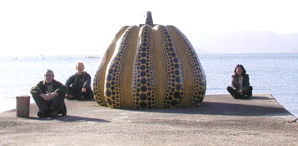
The celebrated pumpkin ‘objet’ in the art display at Naoshima
Japanese like to contemplate the changing seasons, and fall is one time without a cause to celebrate, according to Senoo. That’s why Easter, with bunnies and painted eggs that appear conducive to costume play and merchandising, isn’t likely to take off as easily because spring already has plenty of action, with school and work starting, in Japan.
One area Halloween was likely to grow in coming years is in home decoration, he said. “Halloween has potential for growth because it is so open-ended,” he said, unlike Christmas, for which the market has reached saturation levels. “New Japanese forms of celebrating Halloween can develop.”
***************************
For a comparison with Obon, please click here.
Click here a thoughtful piece on the neo-pagan celebration of death at this time of year.
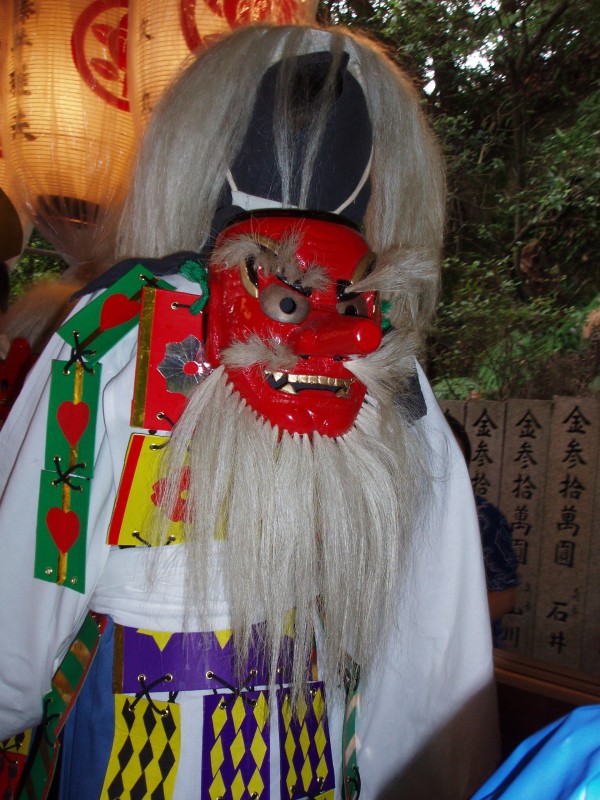
Japan has its own tradition of eerie costumes. Perhaps cosplay is simply a modern take on the tradition.
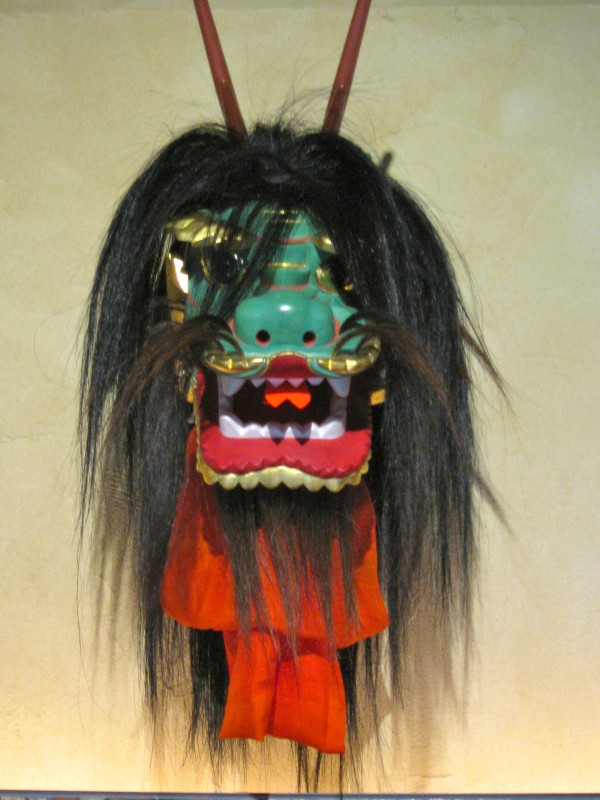
One of the masks used in kagura performances in the Shimane area


Lots of food for thought there John. For example the appeal of the inclusivity of Halloween as an event (cf Valentine’s Day) and it filling a void of sorts in Autumn (cf Easter having problems in Spring). The possible link between cosplay and the costumes/masks used in rituals and festivals is also one I hadn’t pondered. Very interesting. By the way, I was wondering if it was you in the white mask? If so, did you go out and mingle with the crowds?!
Indeed, that was me in the white mask and yes, I did mingle with the crowds in Sannomiya, Kobe, last night. Some excellent costumes, and the variety was amazing. A lot of people put time and money into their costumes, plus there were some elegant cats and seductive witches around. It seems young Japanese have got into the dressing-up aspect in a big way, and the whole thing reminded me of Karnival in Germany where everyone uses the occasion to dress up and get a new personality…
That sounds like a great evening John. Through your post, and comments by the photographer Peter Turnley about getting back to our childhood, my feelings towards celebrating Halloween outside of North America have changed this year.
Yes. An interesting perspective is to see Japanese interest in Halloween as mirroring the Western interest in Shinto…
Very cool!! ;)
Happy Samhain/Halloween, everyone!!
Oh wow, I just noticed you mentioned my blog here! Thank you!!
You’re welcome. It’s a very thoughtful, pioneering blog about integrating Shinto into neo-pagan practice…
According to ancient Ayurveda, these herbs have actually been traditionally made use of to support the body’s natural nerve-calming
procedures.